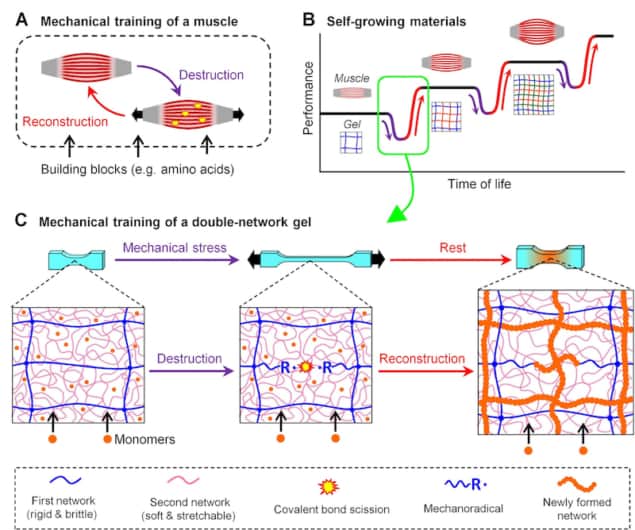
A new material that increases in strength in response to mechanical stress, much like muscle during strength training at the gym, could be used to make fatigue-free structures for a host of industrial applications. The material is made from double-network hydrogels designed to self-repair the damage that occurs when tensile forces are applied.
“This is the first demonstration in the world of a synthetic material improving its properties thanks to supplied ‘nutrients’ in a way that is similar to the process of muscle growth,” explains study lead author Takahiro Matsuda of Hokkaido University in Japan.
Overcoming damage and failure
Biological tissues such as bone and muscle are dynamic materials that change their properties depending on the load applied to them. For example, during strength training, skeletal muscle fibres are destroyed, triggering new tissue growth, a process that makes the muscle stronger overall. Such a property would be very welcome in synthetic materials that generally fail and become damaged following repetitive mechanically applied load and stress.
Matsuda and colleagues made use of double-network hydrogels that mimic the behaviour of natural muscle. These hydrogels are made up of two intertwined networks of polymer strands in which one network is rigid and brittle and the other soft and stretchable. When a stress is applied to the system the rigid strand breaks down. This triggers a localized polymerization reaction that adds new cross-links to the network, thus strengthening the material. The soft, second network keeps its shape and maintains the structure of the bulk gel.
With increased stretching, the hydrogel breaks and “bulks up” even further. Indeed, its strength increases by 1.5 times and its stiffness 23 times. The weight of the polymers increases by 86%.
Double-network hydrogels and monomers
The researchers used a series of double-network hydrogels consisting of poly(2-acrylamido-2-methylpropanesulfonic acid) sodium salt (PNaAMPS) as the brittle network and poly(acrylamide) (PAAm) as the stretchable network. Many other types of double-network gels could be used, however, since they behave in the same way in response to mechanical stress.
They then placed the hydrogel inside a “nutrient” solution containing monomers such as 2-acrylamido-2-methylpropanesulphonic acid sodium salt (NaAMPS) and trifunctional monomer N,N’,N-triacryloyl diethylenetriamine (TADETA). They stretched the samples from an initial gauge length of 15 mm to a gauge length of 90 mm, and then returned them to the initial position. This loading-unloading process was repeated over four cycles.
Self-healing composite could make resilient robot skin
Self-growing fatigue-free tough materials
When the material is stretched, some of its rigid and brittle polymer chains break, which lead to mechano-radical chemical species being generated at the end of the broken chain. These radicals cause the monomers absorbed into the hydrogel to join up to form a polymer network, which strengthens the material. This process is similar to what happens in muscle that needs to be supplied with amino acids – the building blocks of proteins – that join together and form muscle fibres, explains Matsuda.
According to the team, the new work, which is detailed in Science 10.1126/science.aau9533, could help in the development of self-growing fatigue-free tough materials for use in a variety of applications. These include soft robots that can adapt to their surrounding mechanical environment as well as flexible exosuits for patients with skeletal injury that become stronger the more they are used. “To achieve these practical applications, however, we need to improve our system and find a way to provide a sustained monomer supply to it,” Matsuda tells Physics World.



